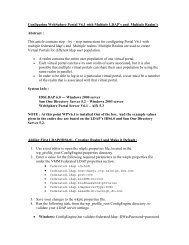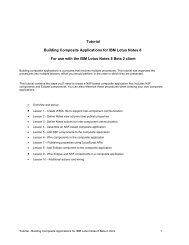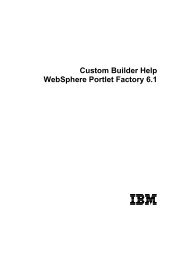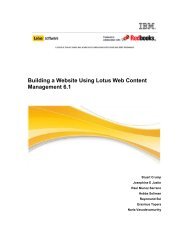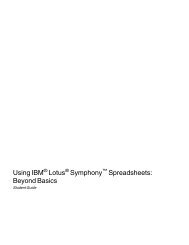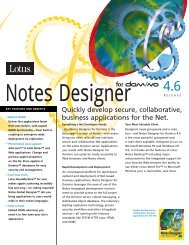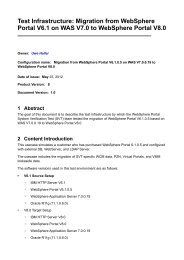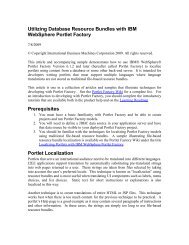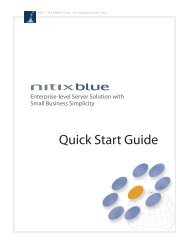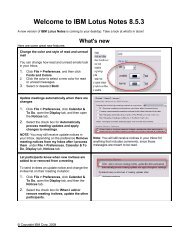IBM WebSphere Portlet Factory Overview - Lotus
IBM WebSphere Portlet Factory Overview - Lotus
IBM WebSphere Portlet Factory Overview - Lotus
Create successful ePaper yourself
Turn your PDF publications into a flip-book with our unique Google optimized e-Paper software.
Creating data servicesAfter you have installed <strong>WebSphere</strong> <strong>Portlet</strong> <strong>Factory</strong> and created your project, the nextstep is to build the data services needed by your portlets. With the rich set of servicesbuilders included in <strong>WebSphere</strong> <strong>Portlet</strong> <strong>Factory</strong>, it is very easy to create portlets basedupon a Service-Oriented Architecture (SOA).Why use <strong>WebSphere</strong> <strong>Portlet</strong> <strong>Factory</strong> builders for SOAWith <strong>WebSphere</strong> <strong>Portlet</strong> <strong>Factory</strong>, you can quickly build portlets where the data and thepresentation layer are all in one model. For example, you can very quickly create anSAP portlet by creating a new model and then adding the SAP View & Form builder toyour model. This one builder allows you to quickly connect to an SAP BAPI and thengenerate input, results, and even detail pages. While this approach is very fast andefficient, it is not the optimal architectural approach.A better approach is to separate the back-end data access from the presentation layer,by creating two models – a service provider model (which accesses the back-end dataand services) and a service consumer model (which provides the front-end userinterface.) By using this approach, you can create a well-defined interface that separatesthe user interface from the back-end data. There are a number of valuable benefits tothis architecture, including:• Reuse - By encapsulating your back-end data and processes into a set of welldefinedservices, you can achieve high levels of reuse across your project.• Flexibility – You can enable independence and flexibility between thepresentation and the services layers, both at implementation and indeployment. For example, you can dynamically swap out the data service thatdrives a portlet user interface, without having to change the user interface.• More efficient division of labor – By breaking development into two primarytasks – creating services and creating user interfaces – you can allocate yourresources more efficiently. Some developers can focus on creating the dataservices, while others can create the user interface or service consumermodels. Teams of developers can work independently on the layers without theneed to constantly coordinate and adjust to modifications made on the otherside.• Automatic service testing support – When creating a service provider model,you can automatically generate a test harness, for easy testing of your backend functionality without requiring front end development.• Offline or disconnected development – By leveraging the service builders,development can proceed without requiring access to the targeted back-endsystems, which helps ease and speed development, especially for the userinterfacedevelopers.<strong>WebSphere</strong> <strong>Portlet</strong> <strong>Factory</strong> V6.0.1 Getting Started Guide - 11 -



